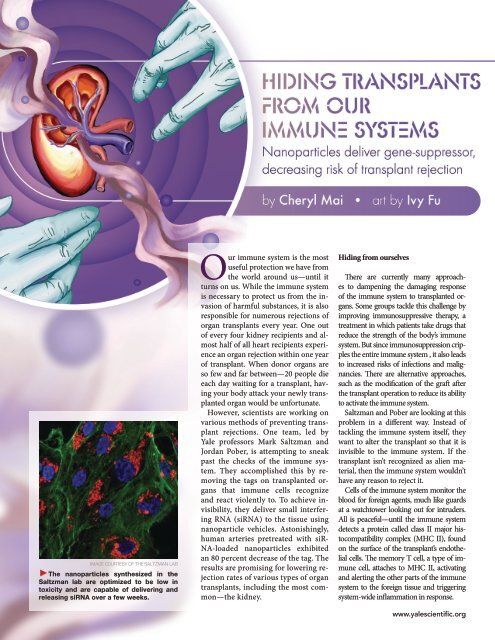YSM Issue 90.4
You also want an ePaper? Increase the reach of your titles
YUMPU automatically turns print PDFs into web optimized ePapers that Google loves.
IMAGE COURTESY OF THE SALTZMAN LAB<br />
►The nanoparticles synthesized in the<br />
Saltzman lab are optimized to be low in<br />
toxicity and are capable of delivering and<br />
releasing siRNA over a few weeks.<br />
Our immune system is the most<br />
useful protection we have from<br />
the world around us—until it<br />
turns on us. While the immune system<br />
is necessary to protect us from the invasion<br />
of harmful substances, it is also<br />
responsible for numerous rejections of<br />
organ transplants every year. One out<br />
of every four kidney recipients and almost<br />
half of all heart recipients experience<br />
an organ rejection within one year<br />
of transplant. When donor organs are<br />
so few and far between—20 people die<br />
each day waiting for a transplant, having<br />
your body attack your newly transplanted<br />
organ would be unfortunate.<br />
However, scientists are working on<br />
various methods of preventing transplant<br />
rejections. One team, led by<br />
Yale professors Mark Saltzman and<br />
Jordan Pober, is attempting to sneak<br />
past the checks of the immune system.<br />
They accomplished this by removing<br />
the tags on transplanted organs<br />
that immune cells recognize<br />
and react violently to. To achieve invisibility,<br />
they deliver small interfering<br />
RNA (siRNA) to the tissue using<br />
nanoparticle vehicles. Astonishingly,<br />
human arteries pretreated with siR-<br />
NA-loaded nanoparticles exhibited<br />
an 80 percent decrease of the tag. The<br />
results are promising for lowering rejection<br />
rates of various types of organ<br />
transplants, including the most common—the<br />
kidney.<br />
Hiding from ourselves<br />
There are currently many approaches<br />
to dampening the damaging response<br />
of the immune system to transplanted organs.<br />
Some groups tackle this challenge by<br />
improving immunosuppressive therapy, a<br />
treatment in which patients take drugs that<br />
reduce the strength of the body’s immune<br />
system. But since immunosuppression cripples<br />
the entire immune system , it also leads<br />
to increased risks of infections and malignancies.<br />
There are alternative approaches,<br />
such as the modification of the graft after<br />
the transplant operation to reduce its ability<br />
to activate the immune system.<br />
Saltzman and Pober are looking at this<br />
problem in a different way. Instead of<br />
tackling the immune system itself, they<br />
want to alter the transplant so that it is<br />
invisible to the immune system. If the<br />
transplant isn’t recognized as alien material,<br />
then the immune system wouldn’t<br />
have any reason to reject it.<br />
Cells of the immune system monitor the<br />
blood for foreign agents, much like guards<br />
at a watchtower looking out for intruders.<br />
All is peaceful—until the immune system<br />
detects a protein called class II major histocompatibility<br />
complex (MHC II), found<br />
on the surface of the transplant’s endothelial<br />
cells. The memory T cell, a type of immune<br />
cell, attaches to MHC II, activating<br />
and alerting the other parts of the immune<br />
system to the foreign tissue and triggering<br />
system-wide inflammation in response.<br />
www.yalescientific.org


















